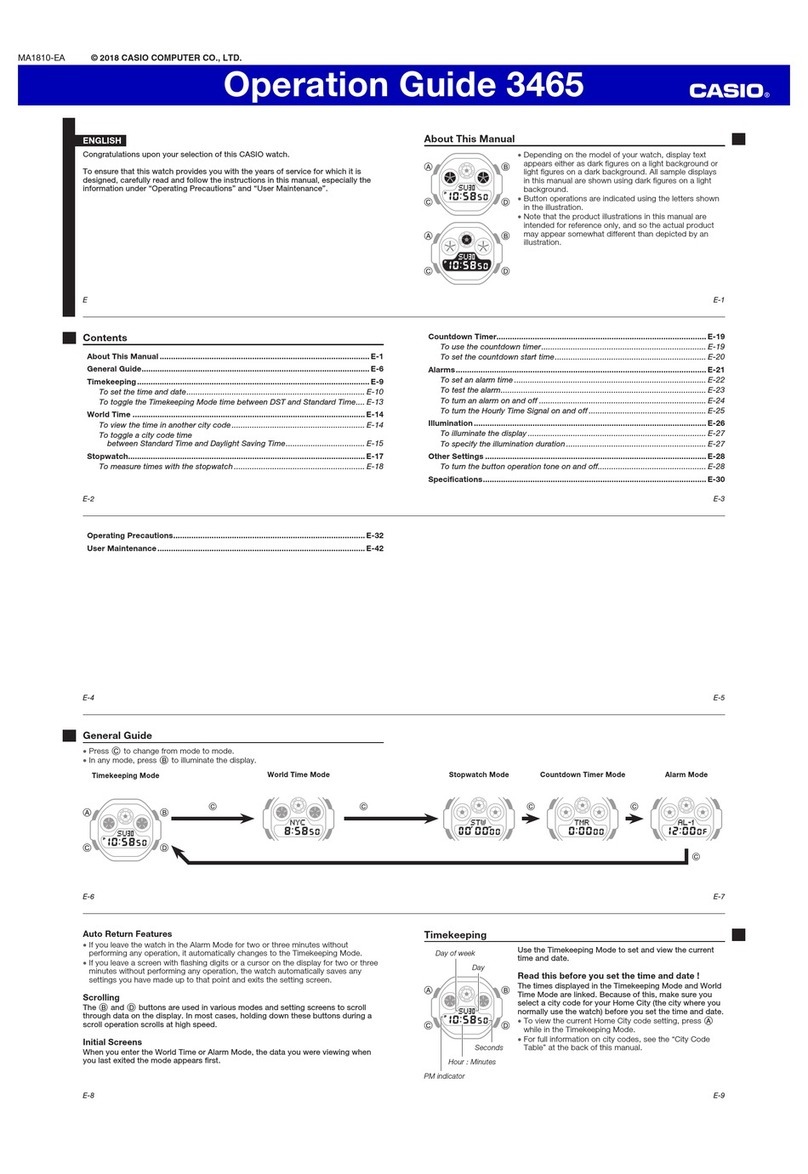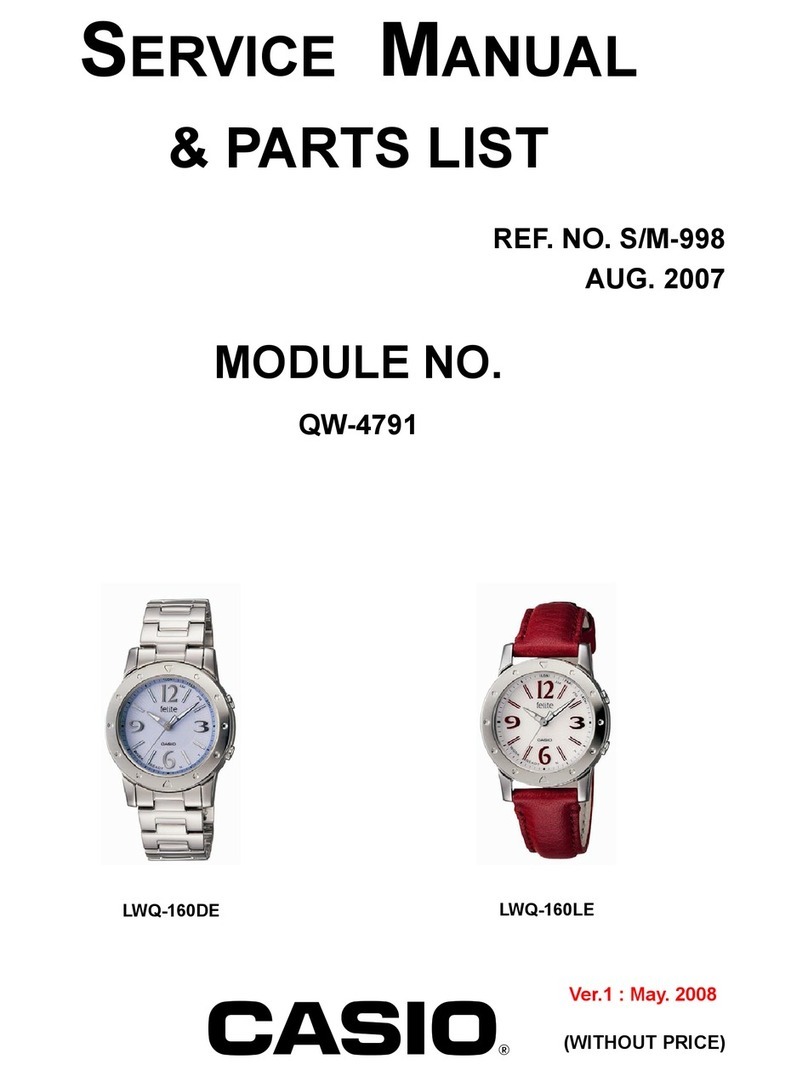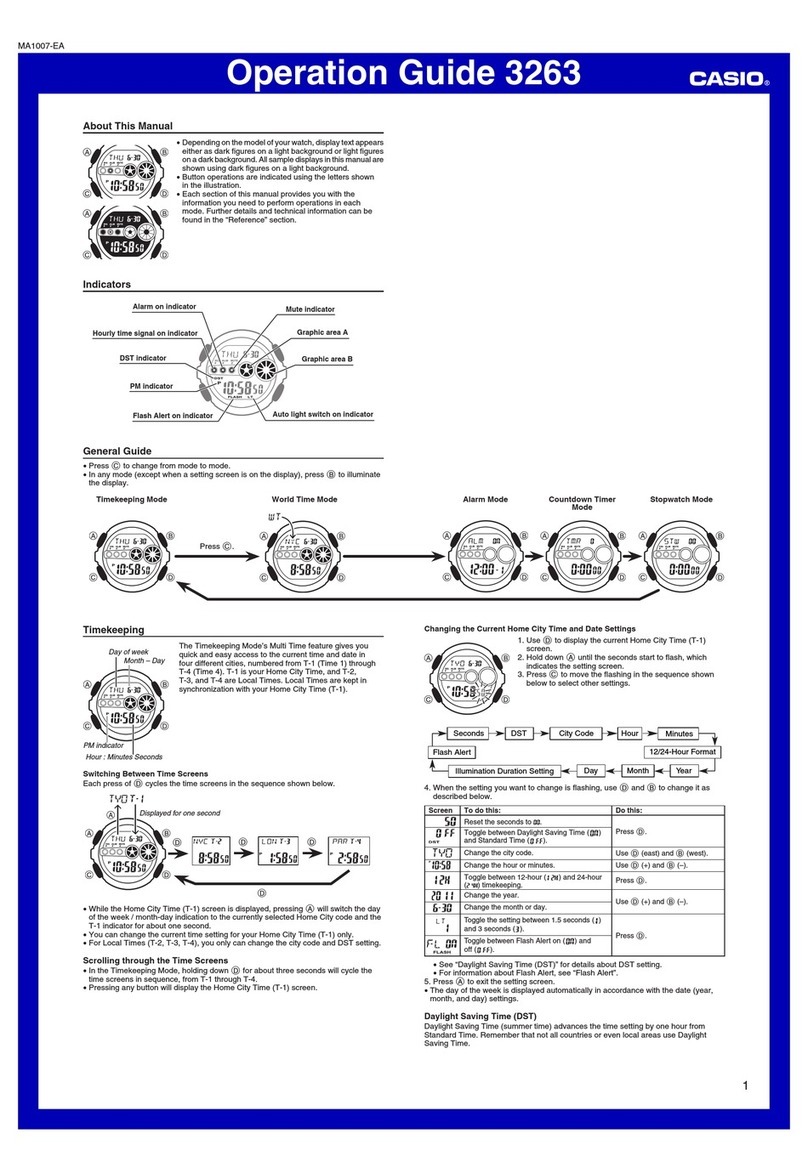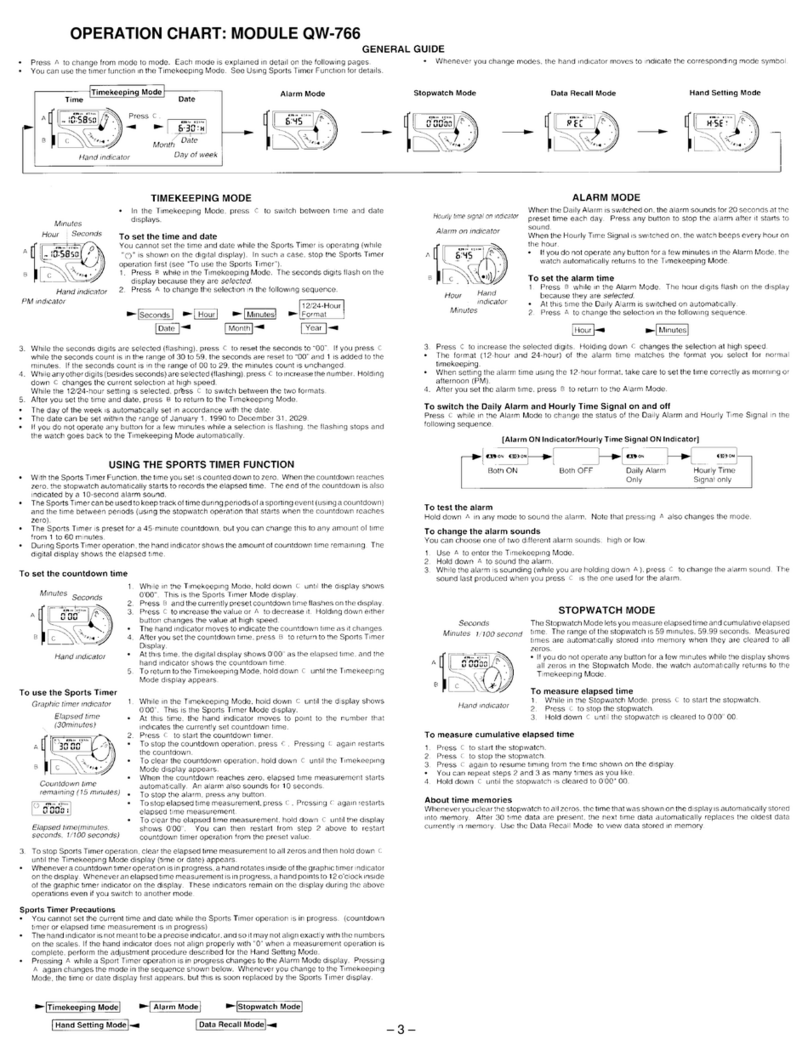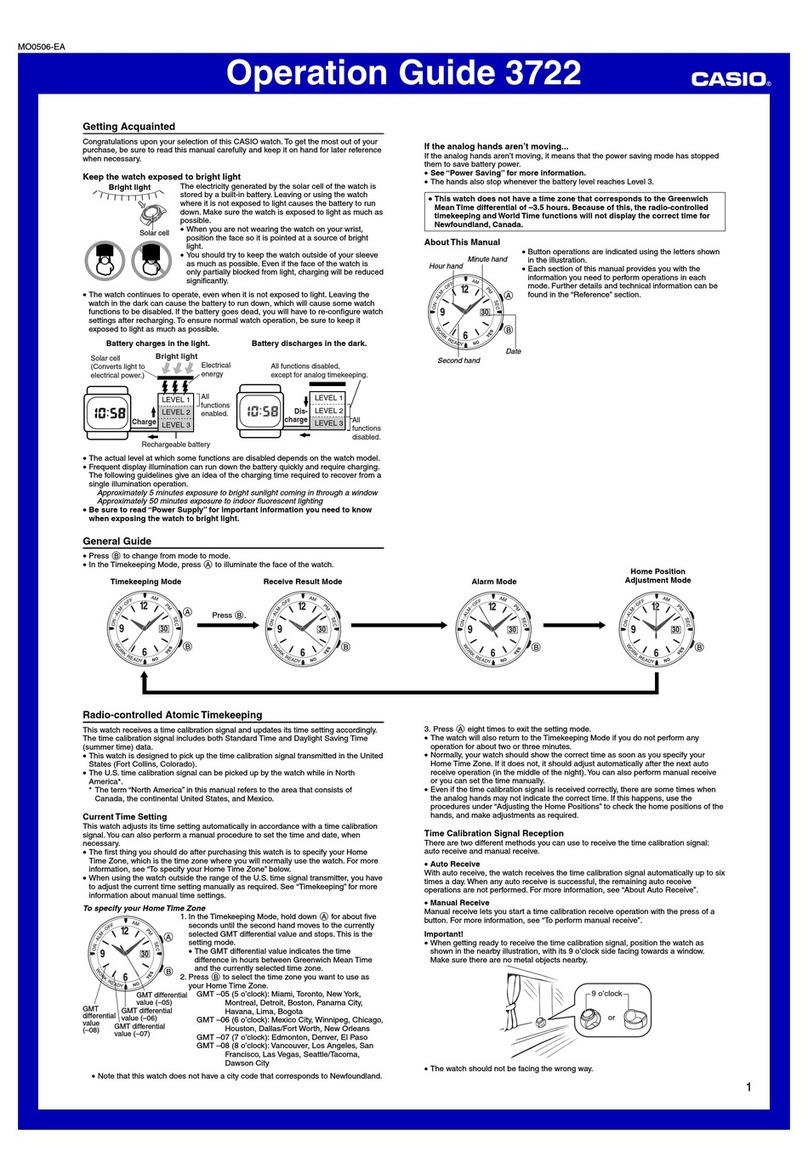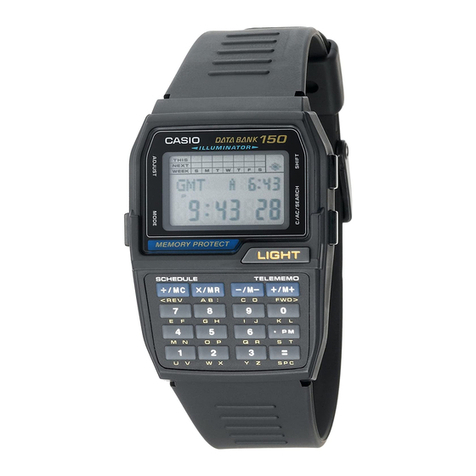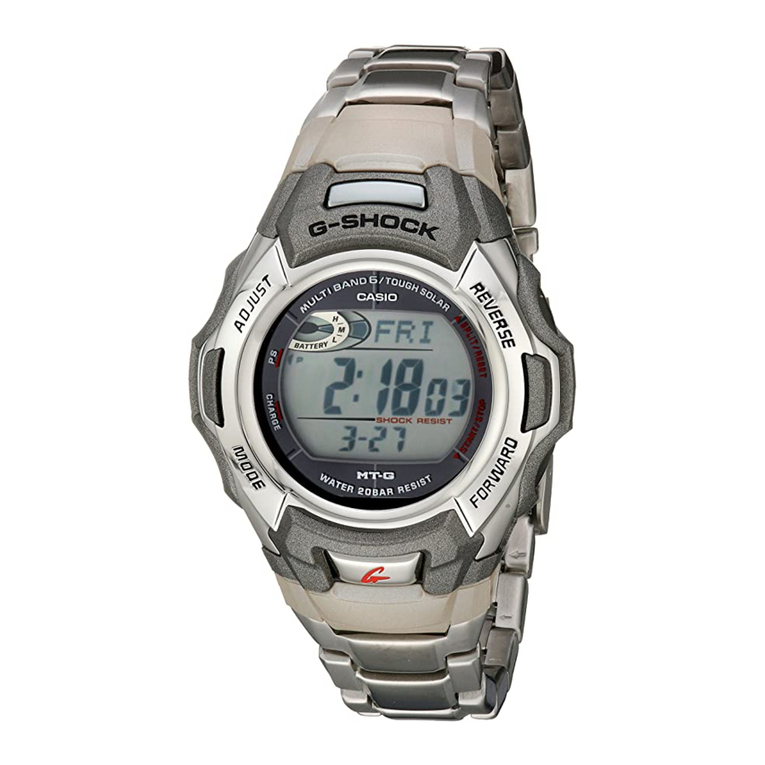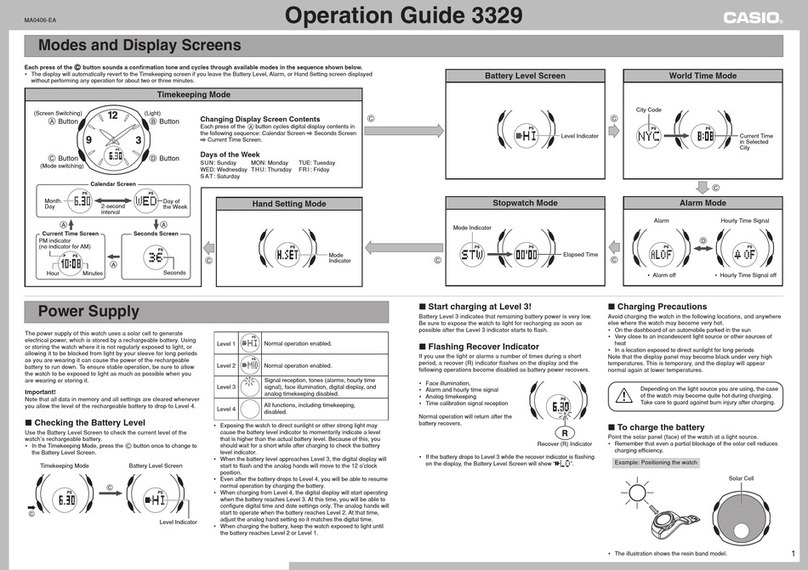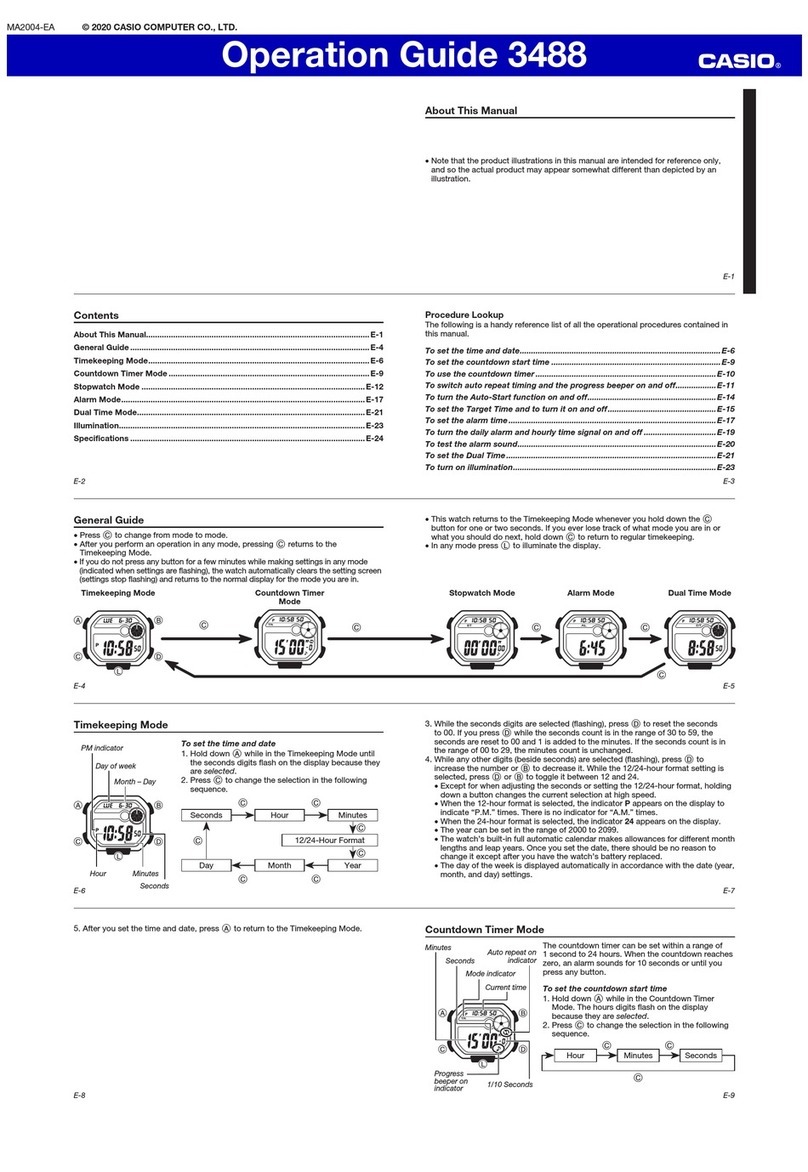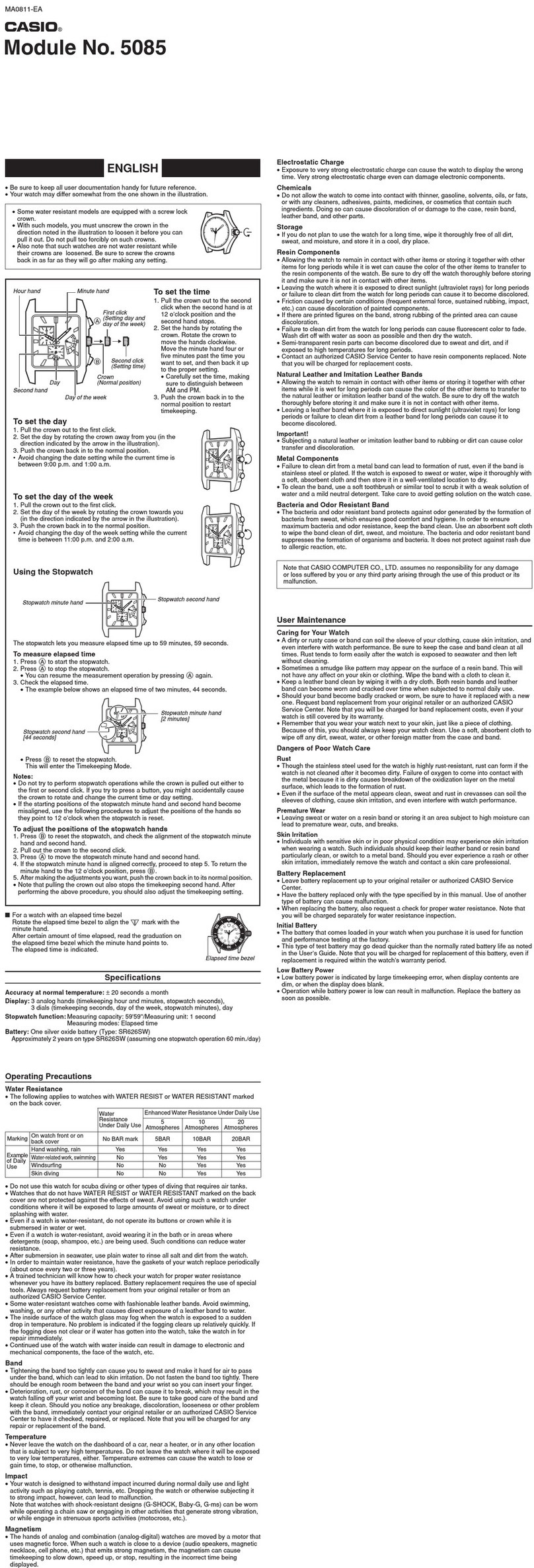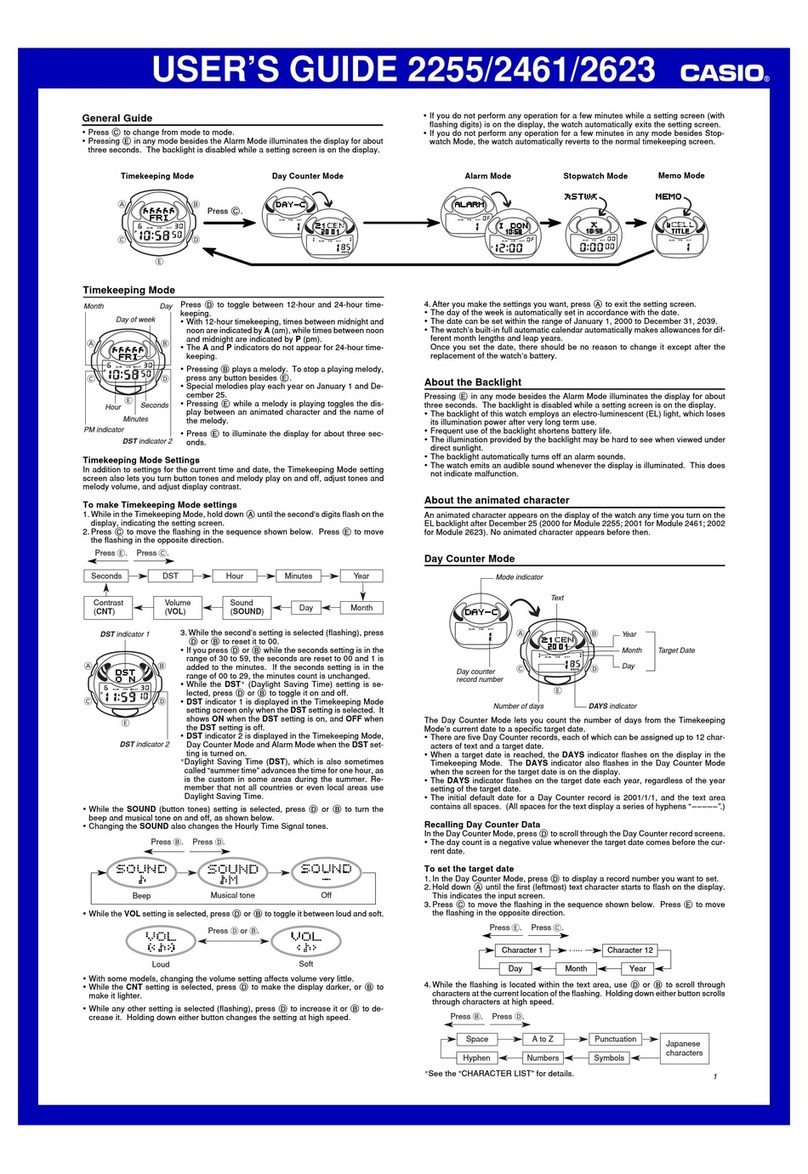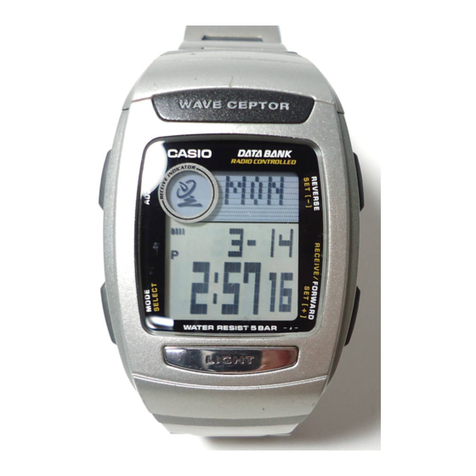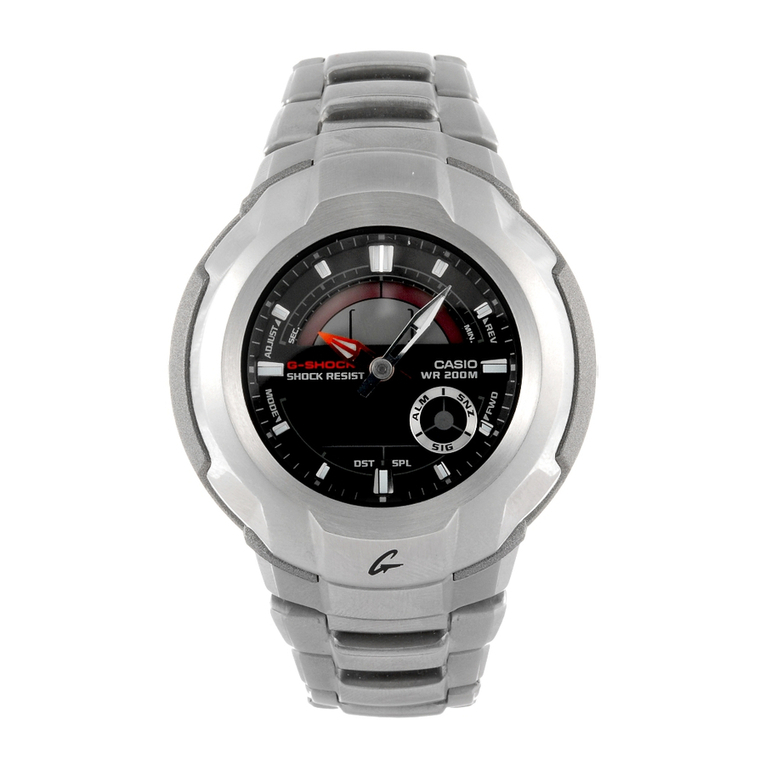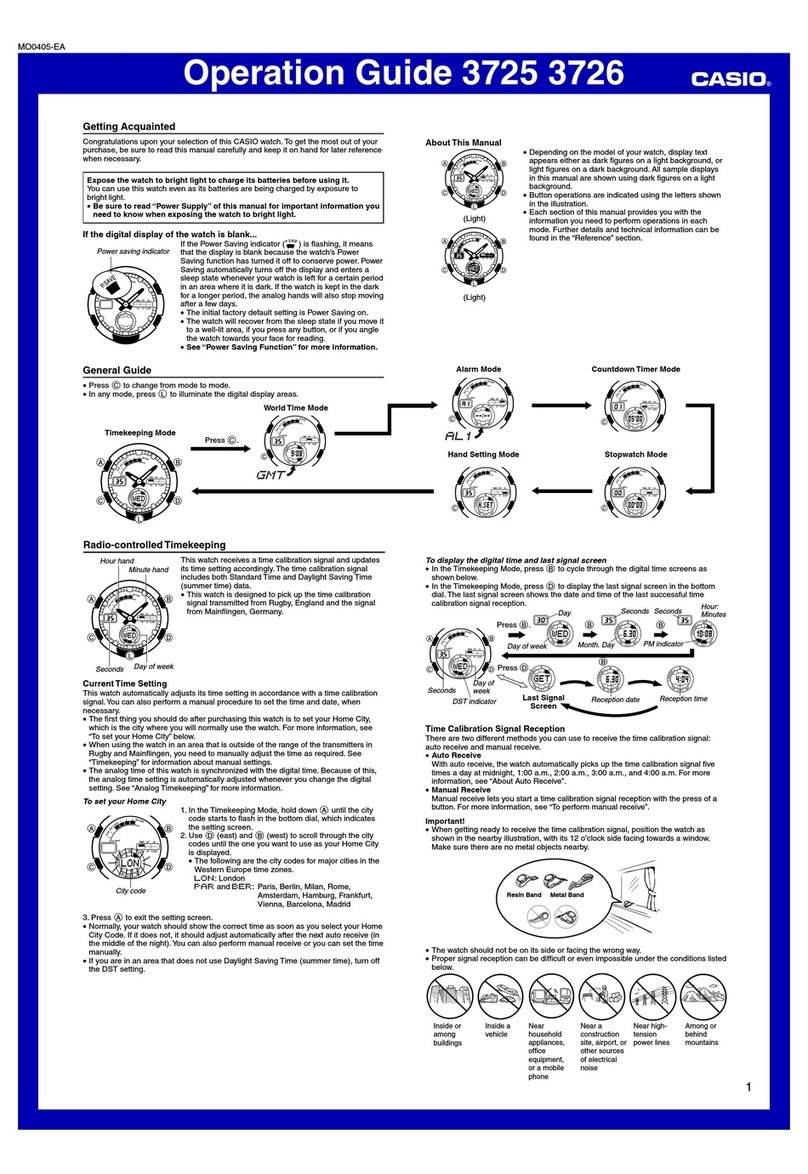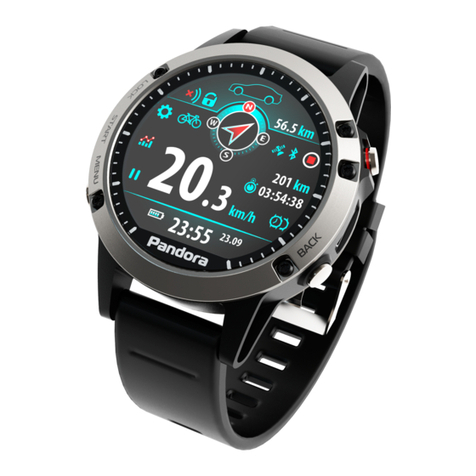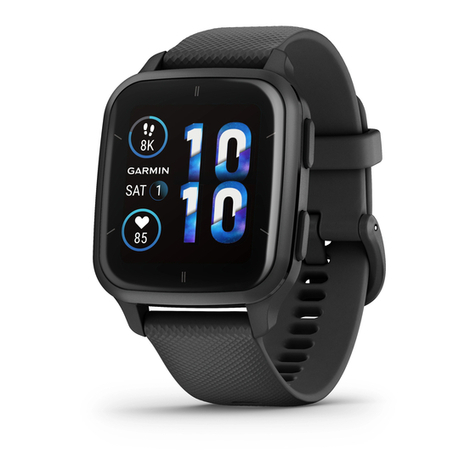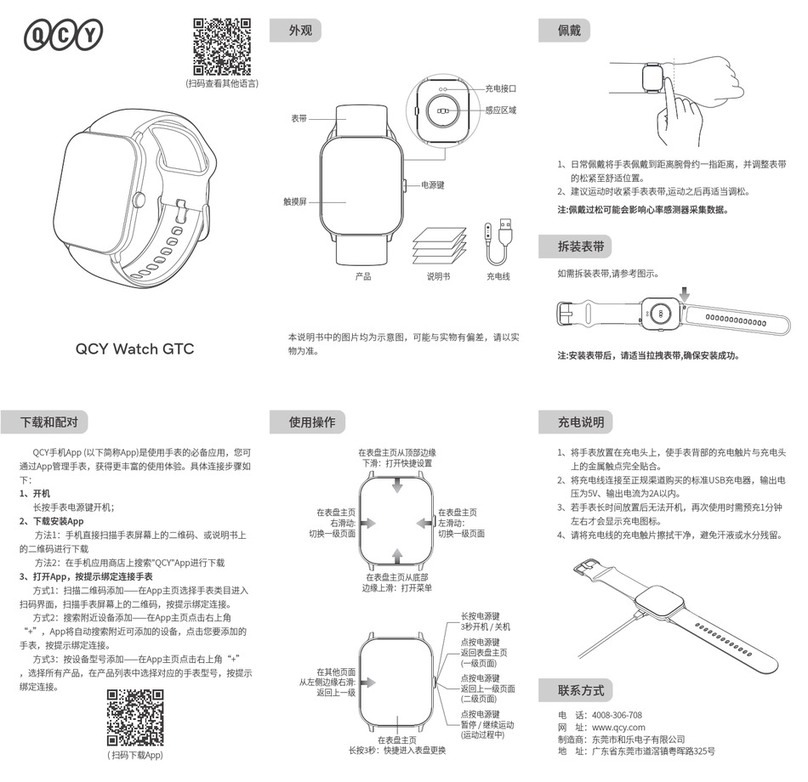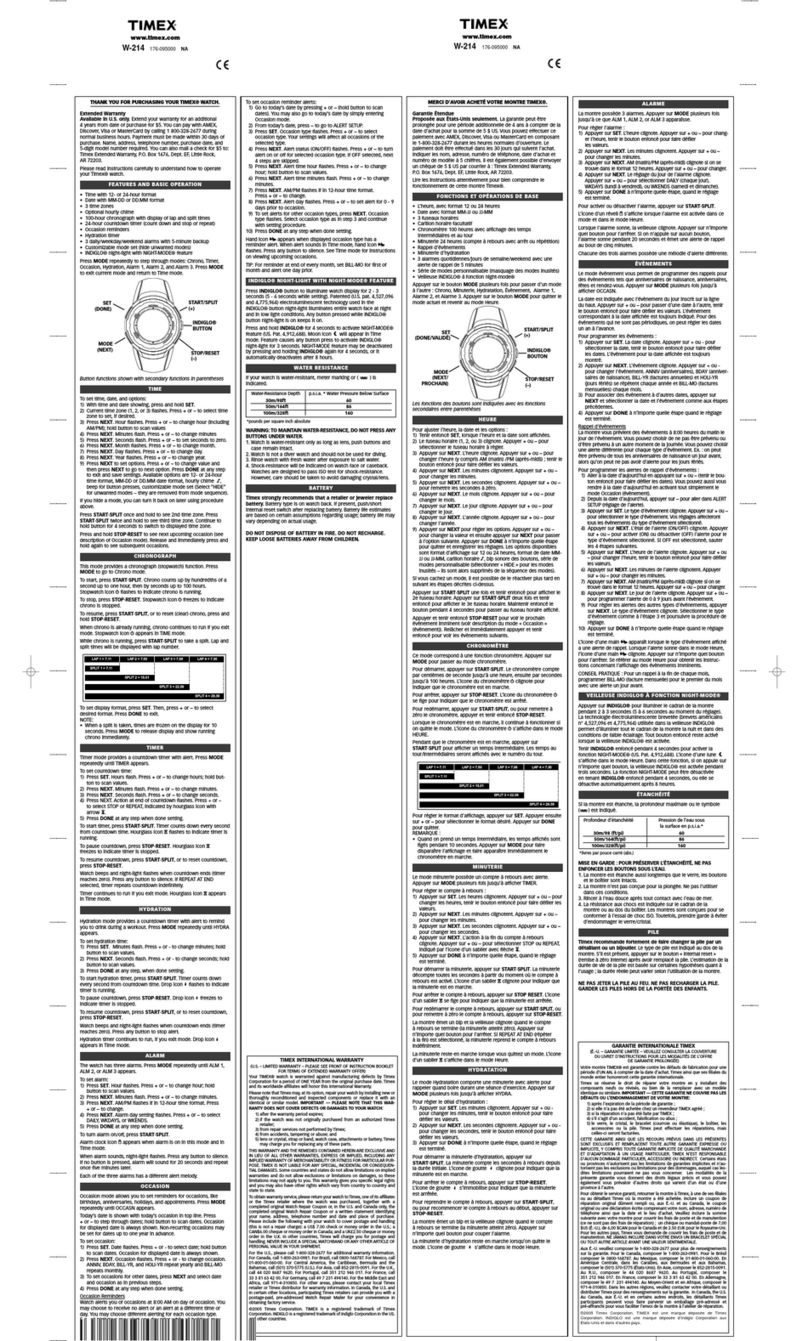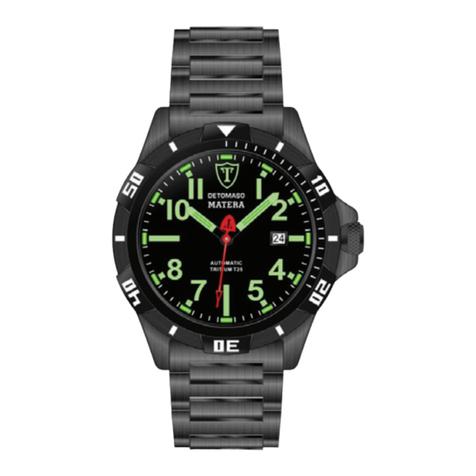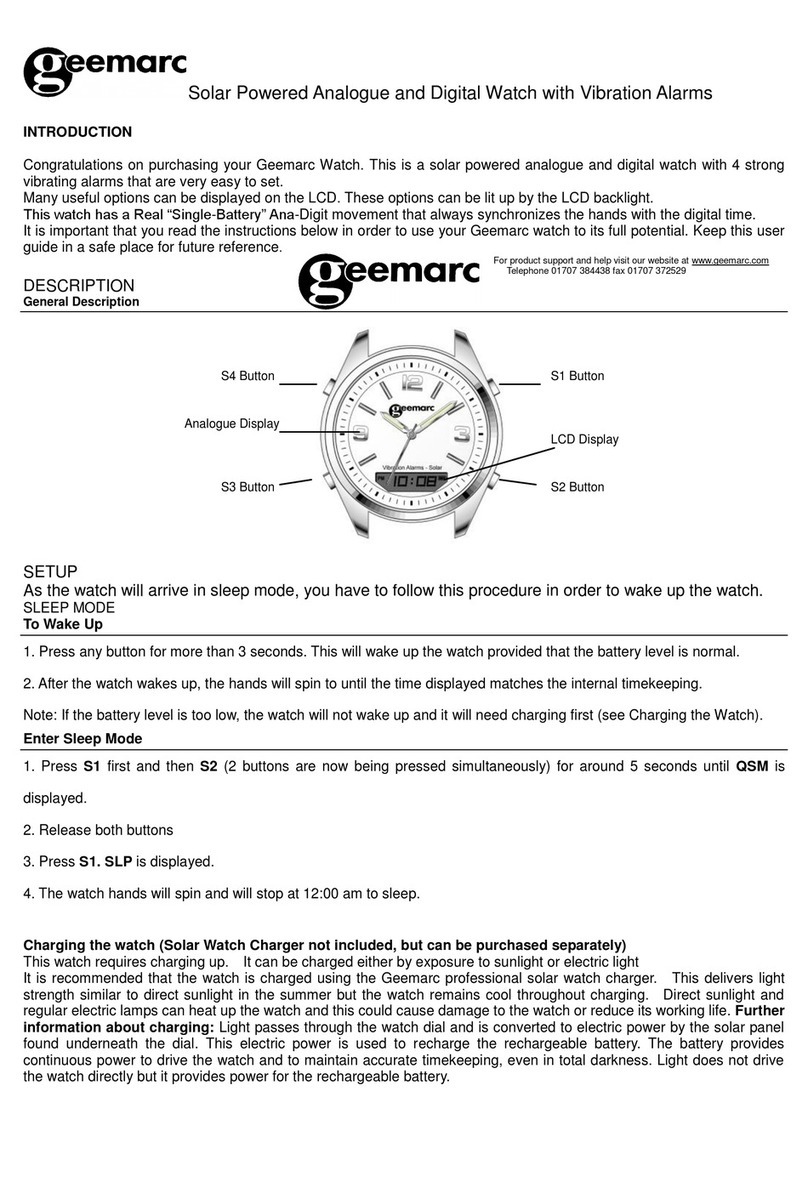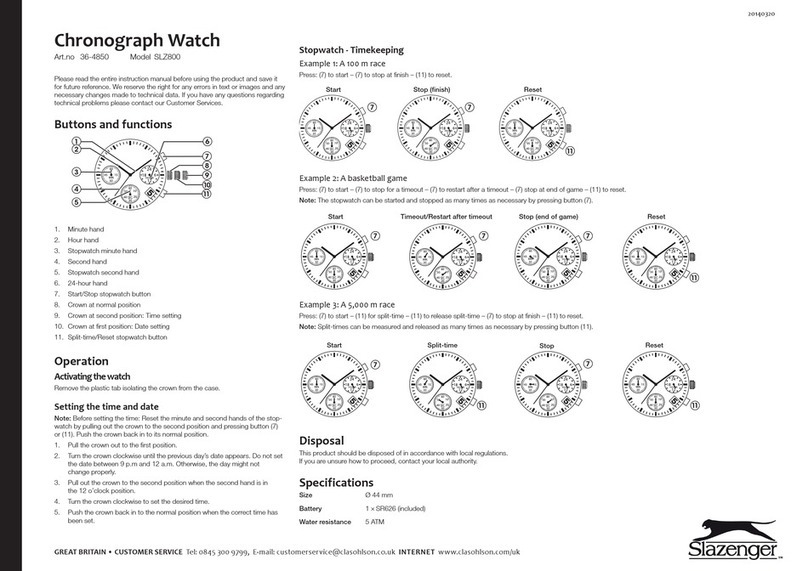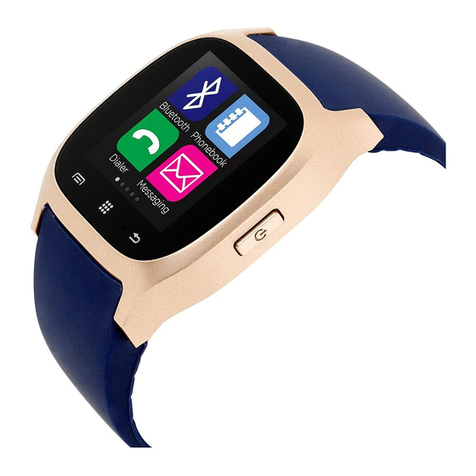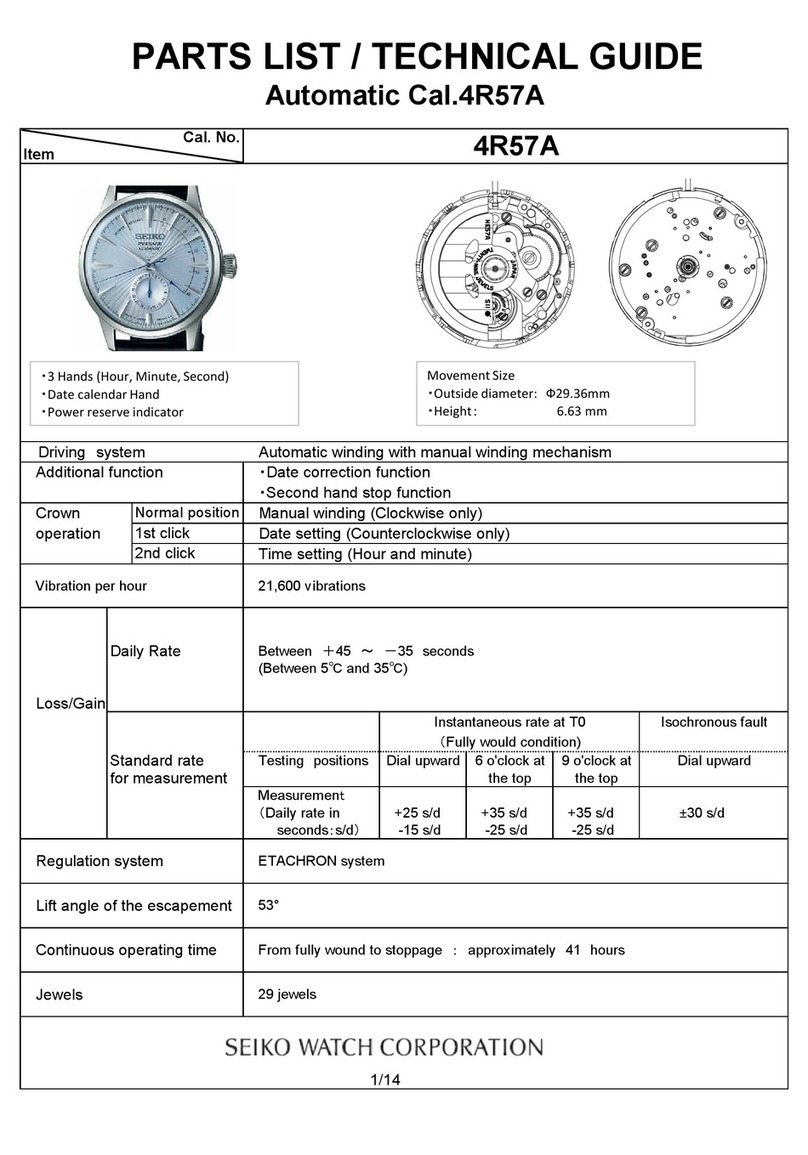
—7 —
To turn Power Saving on and off
1.In the Timekeeping Mode, hold down A until the city
code starts to flash, which indicates the setting screen.
•The second hand will move at high speed to the 12
o’clock position, where it will stop.
2.Press Aagain.
3.Press Cseven times until the Power Saving on/off
screen appears.
4.Press Dto toggle Power Saving on (
ON
) and off
(
OF
).
5.Press A to exit the setting screen.
l
l
l
l
l
l
l
l
l
l
l
l
l
l
l
l
l
l
l
l
•The second hand will advance at high speed to the
correct position in accordance with the digital time
seconds count, and resume normal movement from
there.
•The Power Saving indicator (
PS
) is on the display in all
modes while the Power Saving is turned on.
Auto Return Features
•If you leave the watch in the Alarm, Data Memory, or Hand Setting Mode for two or
three minutes without performing any operation, it automatically returns to the
Timekeeping Mode.
•If you leave the watch with a flashing setting or cursor on the display for two or three
minutes without performing any operation, the watch automatically exits the setting
screen.
Scrolling
The Band Dbuttons are used in various modes and setting screens to scroll
through data on the display.In most cases, holding down these buttons during a scroll
operation scrolls through the data at high speed.
Initial Screens
When you enter the World Time, Alarm, or Data Memory Mode, the data you were
viewing when you last exited the mode appears first.
Time Calibration Signal Reception Precautions
•Strong electrostatic charge can result in the wrong time being set.
•Even when the watch is within the reception range of the transmitter, signal
reception is impossible if the signal is blocked by mountains or other geological
formations between the watch and signal source.
•Signal reception is affected by weather, atmospheric conditions, and seasonal
changes.
•The time calibration signal is bounced off the ionosphere.Because of this, such
factors as changes in the reflectivity of the ionosphere, as well as movement of the
ionosphere to higher altitudes due to seasonal atmospheric changes or the time of
day may change the reception range of the signal and make reception temporarily
impossible.
•Even if the time calibration signal is received properly, certain conditions can cause
the time setting to be off by up to one second.
•The current time setting in accordance with the time calibration signal takes priority
over any time settings you make.
•The watch is designed to automatically update the date and day of the week for the
period January 1, 2000 to December 31, 2099. Setting of the date by the time
calibration signal cannot be performed starting from January 1, 2100.
•This watch can receive signals that differentiate between leap years and non-leap
years.
•Though this watch is designed to receive both time data (hour, minutes, seconds)
and date data (year, month, day), certain signal conditions can limit reception to time
data only.
•When all five auto receptions are successful (0:00 a.m., 1:00 a.m., 2:00 a.m., 3:00
a.m., and 4:00 a.m.), the watch uses the data of the last reception for calibration.
When only one reception is successful, the watch uses the data of the successful
reception.
•Normally, the signal reception date shown by the Last Signal screen is the date data
included in the received time calibration signal.When only time data is received,
however, the Last Signal screen shows the date as kept in theTimekeeping Mode at
the time of signal reception.
•If you are in an area where proper time calibration signal reception is impossible, the
watch keeps time within 15 seconds a month at normal temperature.
•If you have problems with proper time calibration signal reception or if the time
setting is wrong after signal reception, check your current city code, DST (summer
time), and auto receive settings.The following are the initial factory defaults for these
settings.
Setting
City code
DST (summer time)
Auto receive
Initial Factory Default
BER
(Berlin)
A
(Auto switching)
DST
ON R/C
(Auto receive)
Timekeeping
•Resetting the seconds to 00
while the current count is in the range of 30 to 59
causes the minutes to be increased by 1. In the range of 00 to 29, the seconds are
reset to 00
without changing the minutes.
•The day of the week is automatically displayed in accordance with the date (year,
month, and day) settings.
•The year can be set in the range of 2000 to 2099.
•The watch’s built-in full automatic calendar makes allowances for different month
lengths and leap years. Once you set the date, there should be no reason to change
it except after you have the watch’s battery replaced or when battery power drops to
Level 4.
•The current time for all city codes in the Timekeeping Mode and World Time Mode is
calculated in accordance with the Greenwich Mean Time (GMT) differential for each
city, based on your Home City time setting.
•GMT differential is calculated by this watch based on Universal Time Coordinated
(UTC*) data.
* The letters “UTC”stands for “Universal Time Coordinated,”which is the world-wide scientific
standard of timekeeping. It is based upon carefully maintained atomic (cesium) clocks that
keep time accurately to within microseconds. Leap seconds are added or subtracted as
necessary to keep UTC in sync with the Earth’s rotation. The reference point for UTC is
Greenwich, England.
12-hour/24-hourTimekeeping Formats
The 12-hour/24-hour timekeeping format you select in the Timekeeping Mode is also
applied in all other modes.
•With the 12-hour format, the P(PM) indicator appears on the display for times in the
range of noon to 11:59 p.m. and no indicator appears for times in the range of
midnight to 11:59 a.m.
•With the 24-hour format, times are displayed in the range of 0:00 to 23:59.The
indicator 24 indicates the 24-hour format.
InputtingText
The following describes how to input text in the Data Memory Mode.
To input characters
1.When the cursor is on the display, use Band Dto
cycle through the available letters, numbers and
symbols, in the sequence shown below.
Press D.
a
to
z
(lower-case)
(space)
*
to
+
(symbol)
0
to
9
(number) A
to
Z
(upper-case)
Press B.
Data Memory
Input Screen
l
l
l
l
l
l
l
l
l
l
l
l
Cursor
2.When the character you want is at the cursor position,
press Cto move the cursor to the right.
3.Repeat steps 1 and 2 to input the rest of the characters
you want.
HONOLULU
ANCHORAGE
LOS ANGELES
DENVER
CHICAGO
NEWYORK
CARACAS
RIO DE JANEIRO
LONDON
PARIS
BERLIN
City CodeTable
Auto light switch precautions
•Wearing the watch on the inside of your wrist, as well as movement or vibration of
your arm can cause the auto light switch to activate and illuminate the display.To
avoid running down the battery, turn off the auto light switch whenever engaging in
activities that might cause frequent illumination of the display.
•The backlight may not light if the face of the watch is
more than 15 degrees above or below parallel.Make
sure that the back of your hand is parallel to the ground.
•The backlight turns off in about one second, even if you
keep the watch pointed towards your face.
•Static electricity or magnetic force can interfere with
proper operation of the auto light switch.If the backlight
does not light, try moving the watch back to the starting
position (parallel with the ground) and then tilt it back
toward you again.If this does not work, drop your arm
all the way down so it hangs at your side, and then bring
it back up again.
More than 15 degrees
too high
•Under certain conditions, the backlight may not light until
about one second after you turn the face of the watch
towards you.This does not necessarily indicate
malfunction of the backlight.
•You may notice a very faint clicking sound coming from
the watch when it is shaken back and forth.This sound
is caused by mechanical operation of the auto light
switch, and does not indicate a problem with the watch.
City City GMT Other major cities in same time zone
Code
Differential
–––
HNL
ANC
LAX
DEN
CHI
NYC
CCS
RIO
–––
–––
GMT
LON
PAR
BER
PAGO PAGO
PAPEETE
NOME
SAN FRANCISCO, LASVEGAS,VANCOUVER,
SEATTLE, DAWSON CITY
EL PASO, EDMONTON
HOUSTON, DALLAS/FORT WORTH,
NEW ORLEANS, MEXICO CITY, WINNIPEG
MONTREAL, DETROIT, MIAMI, BOSTON,
PANAMA CITY, HAVANA, LIMA, BOGOTA
LA PAZ, SANTIAGO, PORT OF SPAIN
SAO PAULO, BUENOS AIRES, BRASILIA,
MONTEVIDEO
PRAIA
DUBLIN, LISBON, CASABLANCA, DAKAR,
ABIDJAN
MILAN, ROME, MADRID, AMSTERDAM, ALGIERS,
HAMBURG, FRANKFURT, VIENNA, STOCKHOLM
•Based on data as of June 2002.
ATHENS
CAIRO
JERUSALEM
JEDDAH
TEHRAN
DUBAI
KABUL
KARACHI
DELHI
DHAKA
YANGON
BANGKOK
HONG KONG
TOKYO
SEOUL
ADELAIDE
SYDNEY
NOUMEA
WELLINGTON
+2
+3
+3.5
+4
+4.5
+5
+5.5
+6
+6.5
+7
+8
+9
+9.5
+10
+11
+12
HELSINKI, ISTANBUL, BEIRUT, DAMASCUS,
CAPE TOWN
KUWAIT, RIYADH, ADEN, ADDIS ABABA, NAIROBI,
MOSCOW
SHIRAZ
ABU DHABI, MUSCAT
MALE
MUMBAI, KOLKATA
COLOMBO
JAKARTA, PHNOM PENH, HANOI, VIENTIANE
SINGAPORE, KUALA LUMPUR, BEIJING,TAIPEI,
MANILA, PERTH, ULAANBAATAR
PYONGYANG
DARWIN
MELBOURNE, GUAM, RABAUL
PORTVILA
CHRISTCHURCH, NADI, NAURU ISLAND
ATH
CAI
JRS
JED
THR
DXB
KBL
KHI
DEL
DAC
RGN
BKK
HKG
TYO
SEL
ADL
SYD
NOU
WLG
–11
–10
–9
–8
–7
–6
–5
–4
–3
–2
–1
+0
+1
•See the “Character List”for information about the
characters you can input.
Data Memory Management
Data memory can hold up to 315 characters total, while each record can contain up to
63 characters.This means that 40 records can be stored in data memory when each
record contains seven characters of text or less.
Backlight Precautions
•The illumination provided by the backlight may be hard to see when viewed under
direct sunlight.
•The backlight automatically stops illuminating whenever an alarm sounds.
•Frequent use of the backlight shortens the battery life.
±
